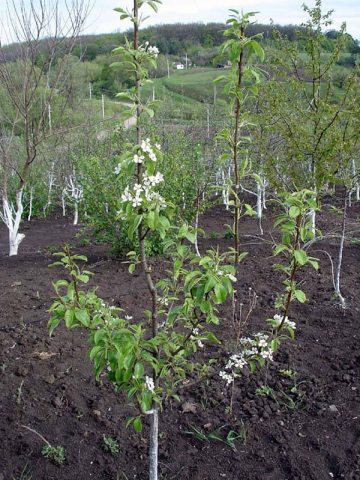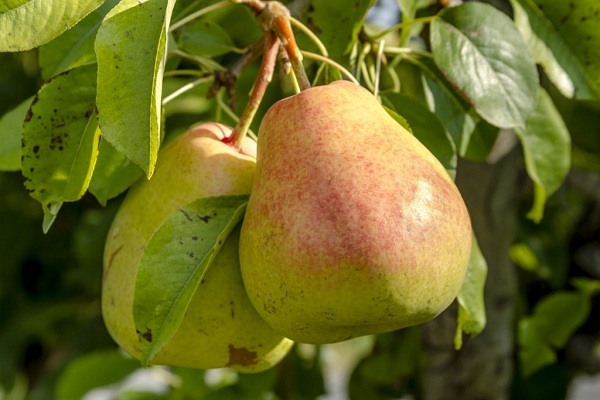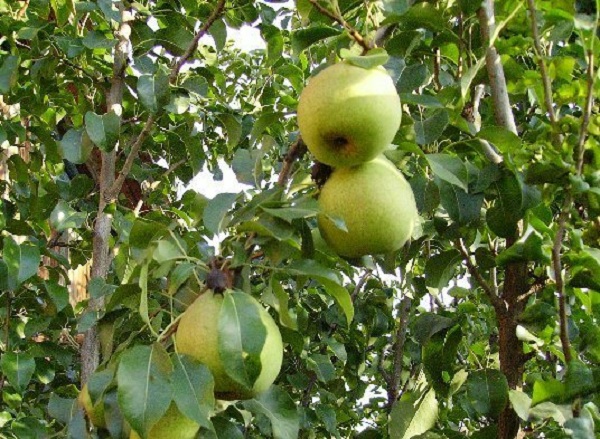Content
Description, photo and reviews about pear Kudesnitsa has established itself as a favorite of summer fruit trees. Thanks to a juicy and large harvest, the Witchcraft quickly spread among amateur gardeners and gardeners. The pear grows quickly, does not require special agronomic skills and is excellent for the development of new varieties of fruit trees.
Description of pear variety Kudesnitsa
A hybrid of a fruit tree was bred on the territory of Belarus by crossing the varieties: Druzhba, Sapezhanka and Lagodna. On the territory of Russia, the Kudesnitsa has been included in the State Register since 2011. The tree is zoned in the Grodno region and grows well in the southern part of Russia. The resulting hybrid is a summer fruit tree. The pear is medium-sized, the crown of the tree is pyramidal, the foliage is of medium density. The branches are strong and flexible.
Kudesnitsa is a winter-hardy pear variety, but a young tree must be protected from frost for the first few years of growth. Due to the long shelf life, the fruits of the Kudesnitsa variety are used commercially. Shoots grow in compact clusters, making harvesting easier. The foliage is ovoid, medium in size with a glossy sheen of bright green. The pear rarely gets sick under comfortable growing conditions.
Fruit characteristics
Fruiting occurs in 4 years from the date of planting the pear. The fruits are symmetrical and have a short pear-shaped shape. The pear color is greenish yellow. Large subcutaneous dots of dark green color are clearly visible on the peel, there are many of them. The ripe fruit tastes sweet with a barely perceptible sourness. The pulp is juicy, fragrant, creamy and medium-bodied. When stored for a long time, the fruit does not wrinkle.
The average fruit weight is from 140 to 170 g. The ripeness of the crop is characterized by a slight pinkish blush on the sunny side of the fruit. Kudesnitsa belongs to high-yielding varieties: from 1 sq. m are harvested up to 130 kg for the summer season.
Harvesting begins from July to the end of August. The shelf life of fruits after harvesting in the refrigerator varies from 1 to 3 weeks. Fruits are widely used in cooking and are useful raw. The fruits are rich in fiber, vitamin E and C. The tasting is estimated at 4.6 points on a five-point scale.
Pros and cons of the Kudesnitsa variety
A significant disadvantage of the fruits of the Magician is that they are not suitable for transportation. The short shelf life is compensated by the juiciness of the fruits, abundant harvest and their attractive presentation. Otherwise, the Kudesnitsa variety has more positive aspects:
- fast appearance and ripening of the first fruits;
- fertility of the variety;
- high winter hardiness;
- unpretentiousness to growing conditions;
- the pear is very rarely sick.
The sorceress does not need pollinators, which makes it possible to plant trees in a single planting. Also, the variety takes root well if other fruit trees grow in the neighborhood.
Optimal growing conditions
The pear is not a drought-resistant variety, but it grows well in the sun. The tree is unpretentious to changeable climate and temperature changes. The best landing site would be the western or southwestern part of the site, which is completely protected from the wind.Kudesnitsa has good fertility in Central and Central Russia, and a bountiful harvest is also found in the Perm region.
The soil should not have wet stagnation, otherwise the roots of the tree will rot. There are no special requirements for the landing site. Experienced gardeners choose drained, loose soil that is low in acidity. The optimal time for planting is October or mid-November. Before the first frost, the tree will take root and get stronger.
Planting and caring for the magic pear
Before planting, the soil is mixed with mineral fertilizers and compost. The deadline for planting is the first frost. A few hours before planting, the seedling is placed in water at room temperature. Then they prune rotten, damaged and strongly protruding roots, which should not dry out until planting.
Landing rules
The planting hole is dug depending on the parameters of the purchased seedling. Agronomists advise sticking to standard sizes: 50 cm in width and depth. A drainage layer is poured at the bottom of the hole, then a layer of fertile soil is placed along with the seedling. To support a fragile seedling, a support stake is driven into the hole. The seedling is poured in layers: each layer is tamped, compost is added. Aryk is made around the planted seedling, then watered with water and after the soil subsides, the soil is poured.
A favorable level for a pear is 3-5 m to the root system of the tree. Otherwise, the pear will not develop and die.
For rapid rooting, the seedling is watered with a solution of a mixture of water, micronutrient fertilizers and growth stimulants. With the onset of spring, the pear is watered abundantly with water: 10 liters every 3 days. Cut off limp or frozen branches. To control pests, they are treated with chemicals.
Watering and feeding
Once fully rooted, the tree does not need frequent watering. One watering every 4-5 days will be enough. For 1 young tree, 2-3 buckets of water should go. The soil is loosened after watering or rain. In the hot summer, the pear is watered every day. In the fall, the tree must be watered at least once a month.
The first feeding is done at planting. The acidity of the soil is reduced with lime or wood ash. For good growth in the first 3 years, mineral fertilizers are added to the soil. After the first harvest, the soil is fertilized only for the winter. If the planting was carried out in an area with black soil, then feeding the pear is not required.
Pruning
A young seedling is pruned if damaged roots, dents on the trunk were found during inspection. In early spring, after removing the shelter, cut off excess, old and dry branches. To obtain the required shape, the crown of the tree is constantly cut or shortened young shoots. In the fall, only the processes damaged by the disease are cut off.
Whitewash
A young tree is whitewashed in early spring and late autumn so that insects and rodents do not damage the trunk and foliage of the pear. Whitewashing is done after complete rooting. For the solution, use diluted blue or copper sulfate with slaked lime. Lime is also used without impurities, but then it is necessary to monitor the consistency of the solution. Usually the trunk of a fruit tree is whitened to half or to the first branches. The protruding roots must be whitened.
Preparing for winter
In the first winter, the seedling is cut to 1 m, all the buds are cut off from the stem, and the ones located above are not touched. After whitewashing, the tree trunk is wrapped in burlap, thick cardboard. The base is sprinkled with dry sawdust or covered with spruce branches. They also use agrofibre from rodent attacks. A young tree with flexible branches can be covered with burlap and wrapped with rope. The base of the trunk is covered with a sheaf of dry hay.
Pollination
The Kudesnitsa variety does not need pollinators. However, the proximity to other fruit trees will help form the first prolific ovary of the crop. Pollinators for pears should bloom at the same time as Kudesnitsa. The following varieties are suitable as pollinators: Clapp's Favorite, Friendship or Lagodna.
Yield
Pear variety Kudesnitsa is characterized by high fertility. In good growing conditions, up to 160 centners are harvested from 3-4 trees. A young tree is capable of producing up to 50 kg of pears in 1 season. Ripening of fruits depends on the region where the pear is grown. The fruits do not overripe, do not crumble, if the harvest is not harvested on time. The presentation and taste of the Kudesnitsa pear does not lose for 2-3 months from the moment of full ripening.
Diseases and pests
Kudesnitsa is a hybrid variety of fruit trees that almost does not get sick during the entire period of growth and fruiting. High immunity is resistant to fungal parasites, but the pear is actively attacked by pests. The foliage of the tree collapses when attacked by aphids, moths spoil the integrity of the fruit, itching and ticks suck the juices from the trunk of the pear. As a result, the young tree dries up quickly and dies.
Pests are very common: gall midge, tube-worms, gall mites and flower beetles, from which the pear can rarely be saved. When the first signs of damage to fruits or shriveled leaves appear, the variety is treated with chemicals, insecticides. Agronomists recommend removing rotten foliage from the tree trunk and pruning dry branches that are just starting to dry.
In the Central region of planting in Russia, pears are susceptible to diseases:
- scab, fungal spores of which infect the fruits and leaves of pear;
- fruit rot, then the fruits of the Kudesnitsa variety are not eaten at all;
- leaf rust - the foliage of the tree becomes covered with black spots and falls off;
- powdery mildew, from which the tree dies very quickly.
From the scab, the seedling is sprayed with a diluted solution of Bordeaux liquid 2-3 times a month. For the prevention of fruit rot, the pear is treated with a lime liquid. At the first signs of rust, the damaged leaves are removed, then the crown is sprayed with Fitoverm. Powdery mildew is very difficult to remove, so it is necessary to notice the first signs of the disease at an early stage. For treatment, use a solution of soda ash with laundry soap.
Reviews of the pear variety Kudesnitsa
Conclusion
Description, photos and reviews of the Kudesnitsa pear fully correspond to the real appearance of the fruit tree. The pear variety continues to spread among amateur gardeners. A mature tree is resistant to frost, pests and diseases. The sorceress rarely gets sick, therefore, the condition, quality and appearance of the fruit attracts buyers. Also, fruits have the presence of fiber and vitamins, which are beneficial for human health.














